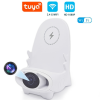Useful
The Eye of Monitoring: The Evolution History of Technology from Mechanical Peep to Intelligent Perception
In the summer of 1942, the first closed-circuit television system in human history was born in Siemens laboratory outside Berlin. This original device designed by Walter bruch was originally used to remotely observe the test picture of V-2 rocket engine, but it unexpectedly opened the era of visual monitoring in human society. This mechanical device, full of steampunk style, transmits fuzzy black-and-white images with vacuum tube circuits, just like the fire stolen by Prometheus, which not only illuminates the road of technological evolution, but also projects the eternal confusion of human beings about security and privacy.
First, the visual revolution in the mechanical age
In the embryonic stage of monitoring technology, the earliest visual monitoring system was formed by the combination of cathode ray tube and mechanical rotating pan/tilt. In 1953, the first batch of public monitoring points appeared on the streets of London, which required operators to manually rotate a metal pan-tilt weighing 30 kilograms in a stuffy control room. These devices, which use selenium photocells for imaging, have a resolution of less than 300 lines, but Scotland Yard has realized real-time monitoring of Piccadilly Circus for the first time.
The technical breakthrough in the era of analog signals occurred in 1969, when the VK-1410 camera launched by Matsushita Corporation of Japan realized the video output of 640×480 pixels for the first time. This technological leap made the surveillance video begin to have evidential value. In 1972, the new york Police Department set up the world’s first urban surveillance network, covering the main blocks of Manhattan with 42 cameras. At that time, the video recording system used 2-inch opening tapes, and each tape could only store 30 minutes of SD images.

The monitoring system in this period gave birth to the unique architectural aesthetics. The iconic hemispherical protective covers at the gates of banks and jewelry stores and the slowly rotating gun cameras in museums constituted the unique safety symbols during the Cold War. The “telescreen” conceived by British writer Orwell in “1984” gained technical substance in this period.
Second, the evolution of monitoring under the digital wave
In 1996, Axis introduced NetEye 200 network camera. This digital revolution completely changed the underlying logic of monitoring technology. With the application of MPEG-4 compression algorithm, the volume of video files has been reduced by 90%. In Shenzhen Science Park, China, Hikvision engineers are debugging the world’s first IP camera with H.264 encoding. This technical iteration not only enables the monitoring center in the City of London to process 3,000 HD video streams at the same time, but also gives birth to new formats of cloud storage and mobile monitoring.
The breakthrough of intelligent analysis technology occurred in 2012, when the research team of the University of Toronto introduced deep neural network into video analysis. The accuracy of face recognition jumped from 72% to 98%. In the smart city project in Pudong, Shanghai, the system can identify the target person from the database of 20 million people in 0.3 seconds. Behavior analysis algorithm can detect pedestrians running suddenly in subway stations, and license plate recognition system allows the electronic police in Beijing Fifth Ring Road to process the illegal data of 6,000 vehicles per hour.
Modern monitoring network has evolved into a complex digital ecosystem. In the command center of Dubai Police Department, the real-time data of 250,000 cameras in the whole city are beating on the giant curved screen, and the AI algorithm automatically marks abnormal events. Over the slums of Rio de Janeiro, police drones and ground cameras set up a three-dimensional monitoring network, and thermal imaging technology penetrated brick walls to capture suspicious heat sources.
Third, the game field of technical ethics
There are 627 cameras per square mile in London’s Canary Wharf Financial City, and ordinary citizens are recorded by different cameras 300 times a day. The human rights dispute caused by this monitoring density reached its climax in 2015 when the European Court of Justice ruled that the data retention instruction was invalid. The concept of “Cybergaze” put forward by Haravi, a technical philosopher, exactly describes the mixed space created by digital monitoring.
Technical countermeasures and monitoring technology are always evolving together. The IR-CUT glasses developed by Japanese engineers can reflect the infrared blinding face recognition system, and the anti-sample sticker developed by the University of Toronto can make AI mistake the parking sign for the speed limit sign. This kind of offensive and defensive game has given birth to new technical ethics standards, and the GDPR of the European Union stipulates that face recognition in public places must be explicitly agreed.

In the blueprint of smart city, monitoring technology is evolving to service. Singapore’s smart lamppost integrates environmental sensors and emergency broadcasting, and Hangzhou’s urban brain uses traffic monitoring data to optimize traffic light timing. This change indicates that monitoring technology may evolve from “the eye of supervision” to “the brain of the city”, which will create new public value while improving safety.
Looking back at the intersection of 5G and Metauniverse, the surveillance camera has evolved from a cumbersome mechanical device to an intelligent terminal with cognitive ability. When the cloud broadcast system of Beijing Winter Olympics uses 8K+VR technology to create an immersive watching experience, what we see is not only the technological progress, but also the continuous expansion of human visual perception boundaries. This 80-year-long technological evolution has always sought a dynamic balance between security and freedom, efficiency and privacy, and what really needs to be calibrated may be the human cognitive dimension of technological civilization.








